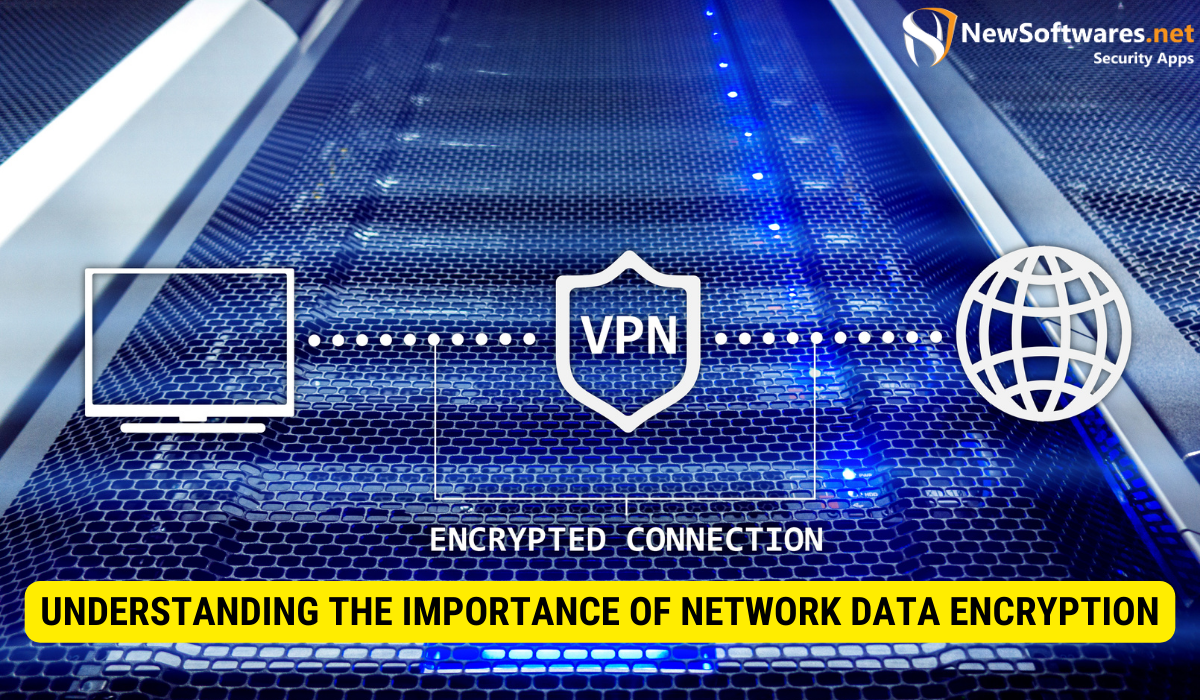To encrypt your network data:
-
Choose Encryption Tool: Select a reliable encryption tool.
-
Identify Data: Determine which data needs encryption.
-
Select Algorithm: Choose an encryption algorithm.
-
Implement Tool: Integrate encryption into your network.
-
Encrypt Data: Use chosen algorithm to encrypt data.
-
Regular Updates: Keep encryption software updated.
In today’s digital world, where cyber threats are ever-present, network data encryption is more important than ever. Whether you are an individual or a business owner, understanding the importance of network data encryption is crucial to protecting your sensitive information from prying eyes.
Understanding the Importance of Network Data Encryption

Data security is a fundamental aspect of any network or online communication. In today’s digital age, where information is constantly being transmitted and shared, it is crucial to ensure that this data remains secure and protected. One of the most effective ways to achieve this is through the use of network data encryption.
Encryption plays a vital role in safeguarding your network data from unauthorized access. By encrypting your data, you are essentially converting it into an unreadable format that can only be deciphered with the right encryption key. This adds an extra layer of protection and ensures that even if your data is intercepted, it remains inaccessible to unauthorized individuals.
The Role of Encryption in Data Security
Encryption serves as a shield against data breaches and cyber-attacks by making it extremely difficult for attackers to make sense of the intercepted information. It helps secure sensitive information such as passwords, financial records, and personal details. Without encryption, this data would be vulnerable to theft and misuse.
When data is encrypted, it is transformed into a series of random characters that are meaningless without the encryption key. This means that even if an attacker manages to intercept the encrypted data, they would not be able to understand its contents without the key. This is especially important when transmitting data over public networks, where the risk of interception is higher.
Furthermore, encryption also ensures the integrity of your data. By encrypting your network data, you can verify its authenticity and ensure that it has not been tampered with during transmission. This is achieved through the use of digital signatures, which are unique identifiers attached to the encrypted data. These signatures can be used to verify the integrity of the data and detect any unauthorized modifications.
Risks of Unencrypted Network Data
Failure to encrypt your network data can lead to severe consequences. Unencrypted data becomes vulnerable to interception, manipulation, and unauthorized access. Cybercriminals are continually on the lookout for unencrypted data to exploit it for their gains. By leaving your network data unprotected, you are essentially inviting trouble.
When data is transmitted over a network without encryption, it is like sending a postcard through the mail without an envelope. Anyone who intercepts the postcard can read its contents without any difficulty. Similarly, unencrypted network data can be easily intercepted and accessed by unauthorized individuals.
Once an attacker gains access to your unencrypted data, they can use it for various malicious purposes. They may steal sensitive information, such as credit card details or personal identification information, and use it for identity theft or financial fraud. They may also manipulate the data, altering its contents to mislead or deceive the intended recipient.
Furthermore, the consequences of a data breach can extend beyond financial losses. A data breach can damage a company’s reputation and erode customer trust. In today’s highly competitive business landscape, where data privacy is a growing concern, customers are more likely to choose companies that prioritize the security of their data.
Therefore, it is essential to prioritize network data encryption as part of your overall data security strategy. By encrypting your network data, you can protect it from unauthorized access, maintain its integrity, and safeguard your reputation. Encryption is not just a nice-to-have feature; it is a necessity in today’s interconnected world.
Basics of Network Data Encryption
Before diving into the process of encrypting your network data, it is essential to understand the basics of network data encryption.
Network data encryption plays a crucial role in ensuring the security and privacy of sensitive information transmitted over networks. It involves converting plain text data into an unreadable format using encryption algorithms. This process makes it extremely difficult for unauthorized individuals to access and understand the data.
When data is encrypted, it is transformed into a form that appears as gibberish to anyone without the correct decryption key. This ensures that even if intercepted, the encrypted data remains useless and unreadable to unauthorized users.
What is Network Data Encryption?
In simple terms, network data encryption is the process of converting your plain text data into an unreadable format using encryption algorithms. To decrypt this data and make it readable again, the recipient must possess the encryption key. Without the correct key, the encrypted data simply appears as gibberish.
Network data encryption provides a secure way to transmit sensitive information, such as personal data, financial details, or confidential business data, over networks. By encrypting the data, it adds an extra layer of protection against unauthorized access and ensures the confidentiality and integrity of the information.
Encryption algorithms used in network data encryption are designed to be mathematically complex and computationally intensive. This complexity makes it extremely difficult for attackers to reverse-engineer the encryption and gain access to the original data.
Key Terms in Network Data Encryption
There are a few key terms you should familiarize yourself with when it comes to network data encryption.
Encryption Algorithm: The encryption algorithm is a set of mathematical rules and procedures that determine how the data is transformed into its encrypted form. Different encryption algorithms have different levels of complexity and security.
Encryption Key: The encryption key is a unique code that allows authorized users to decrypt the data. It is essentially a secret password that unlocks the encrypted data and makes it readable again. Without the correct encryption key, decrypting the data becomes virtually impossible.
Strength of Encryption: The strength of encryption refers to the level of security provided by the encryption algorithm. It is usually measured in bits. The higher the number of bits, the stronger the encryption and the more difficult it is to break. Common encryption strengths include 128-bit, 256-bit, and 512-bit encryption.
Choosing the right encryption algorithm and encryption key strength is crucial in ensuring the security of your network data. It is important to consider the sensitivity of the information being transmitted and the potential risks involved.
Additionally, network data encryption is not limited to a single method or algorithm. There are various encryption protocols and techniques available, such as symmetric encryption, asymmetric encryption, and hybrid encryption. Each method has its own advantages and use cases, depending on the specific requirements of the network and the data being transmitted.
In conclusion, network data encryption is a fundamental aspect of securing sensitive information transmitted over networks. By converting plain text data into an unreadable format and requiring the correct encryption key for decryption, it ensures the confidentiality and integrity of the data. Understanding the basics of network data encryption, including encryption algorithms, encryption keys, and the strength of encryption, is essential in implementing effective security measures for your network.
Steps to Encrypt Your Network Data
Choosing the Right Encryption Tool
There are numerous encryption tools available in the market today. When selecting the right tool for encrypting your network data, consider factors such as ease of use, compatibility with your existing systems, and the level of security it offers. It is also crucial to ensure that the encryption tool adheres to industry standards and is regularly updated to combat new threats.
Process of Encrypting Network Data
The process of encrypting your network data typically involves the following steps:
- Identify the data that needs to be encrypted. Not all data may require the same level of encryption.
- Select the encryption algorithm and encryption key. Different situations may call for different encryption methods.
- Implement the encryption tool within your network infrastructure. This may involve installing software, configuring settings, and integrating with existing systems.
- Encrypt the selected data using the chosen encryption algorithm and key.
- Test the encrypted data to ensure that it can only be decrypted by authorized users.
- Regularly monitor and update your encryption software to stay ahead of emerging threats.
Types of Network Data Encryption
Symmetric Encryption
Symmetric encryption, also known as secret-key encryption, uses a single shared key for both encryption and decryption. This key must be kept secret and shared only between authorized parties. Symmetric encryption is efficient and suitable for encrypting large amounts of data, but it poses challenges when it comes to securely distributing and managing the encryption key.
Asymmetric Encryption
Asymmetric encryption, also referred to as public-key encryption, uses a pair of unique keys – a public key for encryption and a private key for decryption. The public key can be freely shared with anyone, while the private key remains securely with the owner. Asymmetric encryption provides a more secure solution for exchanging encrypted data, but it is slower and less efficient than symmetric encryption for encrypting large volumes of data.
Maintaining Your Encrypted Network

Once you have successfully encrypted your network data, it is crucial to implement measures to maintain the integrity and security of your encrypted network.
Regularly Updating Your Encryption Software
Encryption technology is constantly evolving, and new vulnerabilities are identified regularly. To ensure your network remains secure, it is vital to regularly update your encryption software. Software updates often contain patches and improvements that address newly discovered vulnerabilities and strengthen your network’s defenses.
Best Practices for Secure Network Data
In addition to encryption, there are other best practices you should follow to ensure the security of your network data:
- Implement strong and unique passwords for all network devices and systems.
- Enable multi-factor authentication to add an extra layer of security.
- Regularly backup your data to prevent data loss in case of an attack.
- Train your employees on cybersecurity best practices and the importance of data encryption.
- Monitor network activity and use intrusion detection systems to identify and respond to potential threats.
Key Takeaways:
- Importance of Encryption: Encryption safeguards data, prevents unauthorized access, and maintains data integrity during transmission.
- Risks of Unencrypted Data: Unencrypted data invites cyber threats, leading to potential identity theft, financial fraud, and reputational damage.
- Basics of Encryption: Encryption transforms data into unreadable formats, ensuring confidentiality and requiring decryption for readability.
- Encrypting Your Network: Choose suitable encryption tools, identify data, select encryption methods, implement, test, and regularly update encryption software.
- Secure Network Maintenance: Regular updates, strong passwords, multi-factor authentication, backups, employee training, and monitoring enhance network security.
